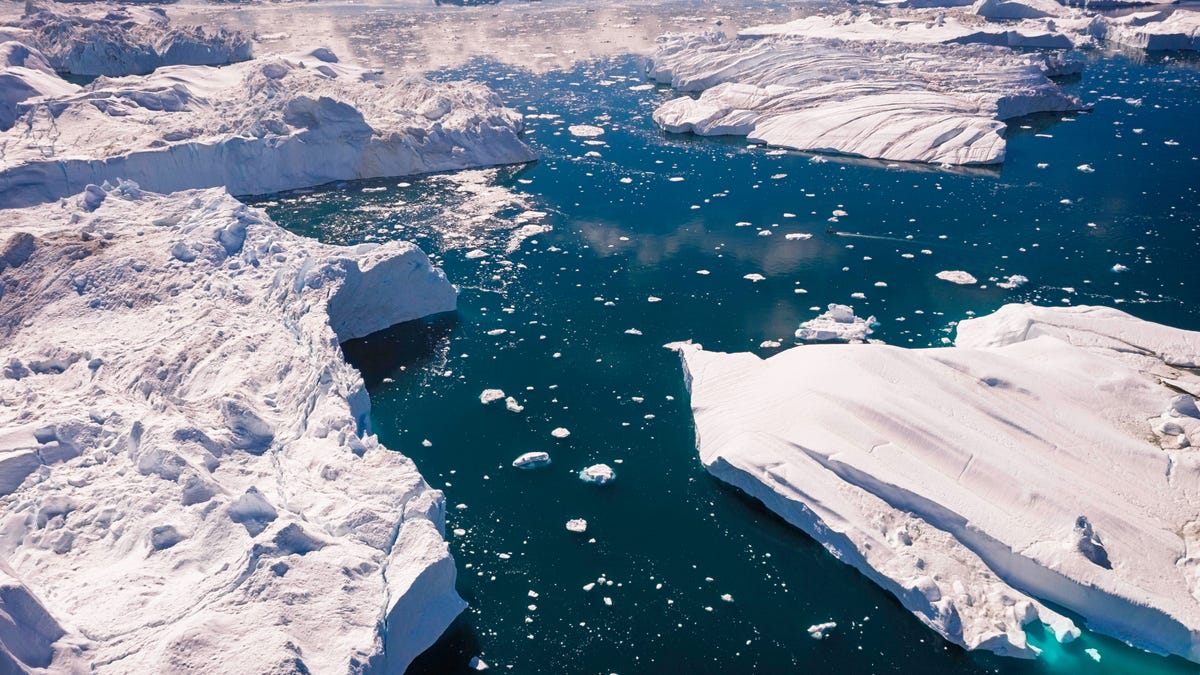Arctic Ocean fossils suggest climate change might not be so great for plankton
Some scientists have predicted shrinking sea ice and more light reaching the Arctic Ocean's surface could mean more plankton. New research suggests otherwise.

Shrinking sea ice may not benefit plankton after all.
Climate change is warming the Arctic Ocean and causing sea ice to shrink. Some of these changes will be irreversible but scientists have predicted the lack of sea ice could see more light reach the ocean's surface, unwittingly leading to a boon in plankton. The tiny organisms sit at the bottom of the food web and are critical for fish and other sea life to feed on.
In 2020, huge blooms of one type of plankton were spotted in the open Arctic. Researchers have recorded an increase in plankton productivity and shown climate change is providing a lot more space to expand into as sea ice diminishes. Sounds good? It might not be.
According to a study published in Nature Geoscience on Monday, shrinking sea ice may spell doom for plankton.
A team of scientists led by Princeton University and the Max Planck Institute for Chemistry used fossilized plankton and ice cores to examine the history of sources and supply rates of nitrogen, a vital nutrient for plankton, to the western and central open Arctic Ocean.
Their research suggests with global warming, these waters will have less nitrogen -- negatively affecting plankton productivity.
"Looking at the Arctic Ocean from space, it's difficult to see water at all, as much of the Arctic Ocean is covered by a layer of sea ice," said Jesse Farmer, lead author of the study, geoscientist at Princeton University and visiting postdoctoral fellow at the Max Planck Institute for Chemistry, in a statement. That sea ice naturally expands in the winter and contracts in the summer. In recent decades, global warming has led to a rapid drop in summer sea ice coverage, with that ice cover now being around half of what it was in 1979.
While melting sea ice should mean photosynthesizing plankton making up the base of Arctic food webs could reap the benefits of having more light, there's a catch, according to contributing author Julie Granger, an associate professor of marine sciences at the University of Connecticut.
"These plankton also need nutrients to grow and nutrients are only abundant deeper in the Arctic Ocean, just beyond the reach of the plankton," Granger said. Whether plankton can get those nutrients is a matter of how "stratified" the upper ocean is, or how much it's separated into layers. The upper 600 feet of the ocean is made up of layers of water with varying densities, based on temperature and saltiness.
"When the upper ocean is strongly stratified, with very light water floating on top of dense deep water, the supply of nutrients to the sunlit surface is slow," Farmer said.
New research found the amount of nitrogen in the Arctic has changed since the last ice age, showing the history of stratification in the Arctic Ocean. The Arctic is where the Pacific and Atlantic oceans meet. Fresh Pacific water flows over the saltier water from the Atlantic, which leaves the western Arctic packed with nitrogen flowing in from the Pacific.
It wasn't always like that.
"During the last ice age, when the growth of ice sheets lowered global sea level, the Bering Strait didn't exist," Daniel Sigman, professor of geological and geophysical sciences at Princeton, said in a statement. Back then, the Bering Strait was instead the Bering Land Bridge, which connected Asia and North America and allowed humans to migrate to the Americas.
At the end of the ice age 11,500 years ago, when ice sheets melted and sea levels went up, the Bering Land Bridge was submerged, allowing nitrogen from the Pacific to creep into the open western Arctic basin.
During the last ice age and under colder climate, stratification in the Arctic was weak. After the ice age, central Arctic stratification became stronger, peaking during a time of naturally warmer Arctic summer temperatures some 10,000 and 6,000 years ago, a time known as the Holocene Thermal Maximum. Since then, stratification in the central Arctic has grown weaker, which has allowed the deeper nitrogen to move up towards the surface, where it can be used by plankton.
The climate crisis is seeing warmer temperatures in the Arctic, returning it to a climate similar to the Holocene Thermal Maximum. Although some scientists have suggested increasing amounts of sunlight touching the ocean could make Arctic plankton more productive, scientists from Monday's study found this isn't likely because of nitrogen availability in open regions of the Arctic. Low nitrogen means poor plankton productivity and hurts one of the foundational organisms in the ecosystems food web.
"Given our data, a rise in open Arctic productivity seems unlikely," Farmer said. "The best hope for a future rise in Arctic productivity is probably in the Arctic's coastal waters."

